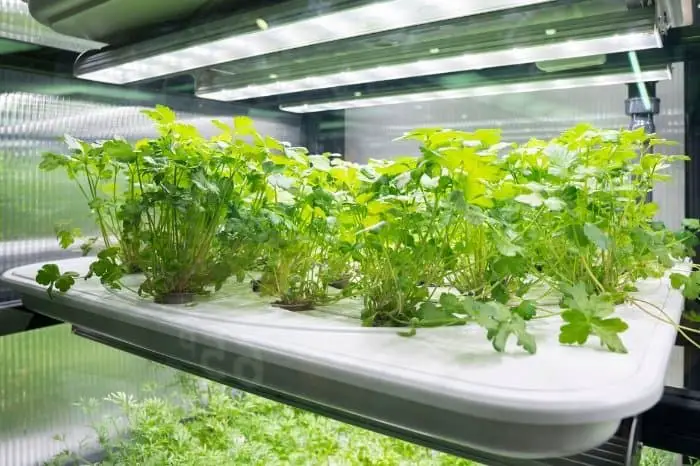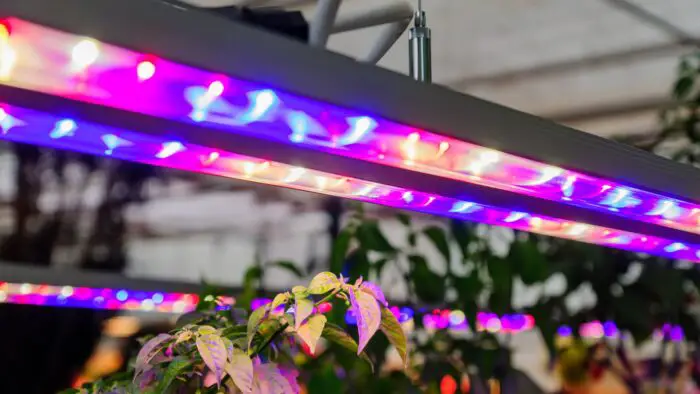Last Updated on February 22, 2023
Imagine an instance where you’ve got everything ready for your indoor hydroponics farm and this question pops into your mind; how many watts per plant for LED grow lights should I provide my plants with? If you do not know how to answer this question, this post will help you determine the wattage to provide your plants so that they grow optimally under your LED grow lights. Let us begin.
Wattage as Plant Indicator for Grow Light
Wattage in the real sense shouldn’t be the actual indicator for your grow lights. It does not determine the amount of energy your plant receives to grow. You should only use watts as a guideline for working out the energy of grow light fixtures that you should use.
One of the keys to successfully growing your plants in a given area using grow light intensity is getting to know and understand the light spectrum.
Watts will however help you calculate or determine the amount of electricity consumed by the grow lights. This will help in terms of knowing your costs, and possibly working out cost-saving methods if you need to. However, if we look at it this way; more energy consumption results in more light for your plants’ growing needs. We can then assume wattage to be an indicator.
How Many Watts Per Plant LED Grow Lights?
Let’s take a look at this using square feet per plant. The first thing you need to do is measure the size of your grow space or tent by square feet. After you have determined the area, use this measurement to purchase the LED grow light of appropriate light intensity. If you are still unsure, you should consult the light specialist at the light store.
Note that other factors may also determine your choice of LED to-grow lights. These factors will help in choosing the appropriate light intensity required for the growth of your plants.
Factors for choosing LED to grow light per plant
How many watts your plants will require will vary depending on these factors:
- Type of plant: the type of plants will fall into the category of high light demanding or low light demanding. High-light demanding lights include peppers, tomatoes, etc. While low light-demanding plants include leafy greens and herbs such as lettuce, basil, watercress, kale, etc.
- Grow space or tent: the area of your grow space will determine the number of watts needed. A large grow space or tent will demand more power while a small grow space will demand less.
- Growth stage: the various stages of a plant’s life cycle will also determine how many watts for LED grow light are required. The various growing stages are seedlings, vegetative, flowering, and fruiting which all require a different amount of light.
VIVOSUN 48″x24″x60″ Mylar Hydroponic Grow Tent with Observation Window and Floor Tray
Watt per square foot of plants
Deciding on the appropriate light per square meter of your grow space or tent is crucial. The various sizes of your grow room or tent will require different intensities of light.
Here are the recommended watts per square foot of a plant:
- 2 by 2 feet (4 sq. ft) will require between 120 to 140 watts.
- 2 by 4 feet (8 sq. ft) will require between 240 to 280 watts.
- 3 by 3 feet (9 sq. ft) will require between 280 to 340 watts.
- 4 by 4 feet (16 sq. ft) will require between 420 to 480 watts.
- 4 by 5 feet (20 sq. ft) will require between 600 to 650 watts.
- 5 by 5 feet (25 sq. ft) will require between 780 to 840 watts.
- 6 by 6 feet (36 sq. ft) will require between 1000 to 1200 watts.
Generally, you should know that the number of watts increases by square feet. This also depends on how many plants will be grown in this area.
Let’s take a look at how many watts per square foot using the number of plants grown in a particular area.
- 1 plant per square foot will require 30 to 40 watts.
- 2 plants per square foot will require 60 to 80 watts.
- 8 plants per square foot will require 240 to 300 watts.
- 10 plants per square foot will require 300 to 340 watts.

Manufacture’s Watt vs Actual Watt
The LED you find in the market will have their printed manufacturer’s wattage. However, the actual watt to run it is usually different.
For instance, if it goes for 3-watt diode electric power and you run it by that 3 watts; you will be drawing or burning out all the power. The recommended usage should be around 60% power of what is given or listed.
How Many Watts Per Square Foot for LED Grow Lights?
The general rule of thumb with grow light wattage is 32 watts per square foot of LEDs. Thirty-two watts should be enough to cover every inch of that square foot. You can go a bit lower to 30, and higher to 40, but these limits should not be exceeded.
This should be the goal, but to get the best results, it would still depend on a variety of other growing conditions that you have. These include the number, type, and size of plants that you have. What matters the most is that the right amount of usable light reaches each square foot of the growing area.
To calculate the correct amount of wattage that will reach your grow room space, you must first accurately identify the size of your grow room. Wattage, however, should not be the determinant of your coverage area, and it should not dictate the effectiveness of the grow light that you get. It should only be used as an approximation to get the correct fixture for your growing space. This means that you must use wattage to guide you on how much power your grow light can give per square foot of the grow room.
Photosynthetic Photon Flux Density or PPFD, measured in μmol/j/m2, and DLI (Daily Light Integral) are the appropriate metrics for measuring light intensity over a specific growing area.
The PPFD measures the total amount of light that is emitted by a light source per second. It also indicates how much light intensity (PAR) you need to grow your plants is created.
How Many Watts of Light for Seedlings?
Seedlings generally require about 32 watts per square foot of seedlings for LED grow lights and 100 watts per plant for CFLs. On top of this, they also require the right color temperature to grow and thrive. The ideal temperature you should choose is in the range of 3500 to 6500 kelvins.
It is important to keep in mind that “watt” measure the amount of energy that light uses, not how much light is emitted. Yes, the wattage will give you an indication of how much light will be emitted. It is important to understand this while choosing lights for seedlings.
Another important factor to consider is the distance at which you should place your grow lights, from the seedlings. Ideally, the space should be 6 inches to get the best results. For easy movement of the lights, you can create or build some system using chains that will allow you to suspend the light fixtures. You can also mount your lights somewhere and elevate the plants on a table or something similar to this seed starting station.
To keep your grow lights working efficiently over a long period, you must consistently wipe down the light tubes to remove dust, grease, and grime before using them each year.
Regardless of the type of light bulb you use for your grow lights, using lumen output to determine the right grow light use for seedlings might be better than using watts. The general rule with lumens; the higher the number of lumens, the brighter the light will be.
Conclusion – How Many Watts Per Plant for LED Grow Lights?
This article has provided you with all the information you need to understand the concept of growing light wattage used for growing plants. The rule of thumb is 32 watts per square foot of growing area. But remember to take into account the other factors that come into play when choosing a grow light. Familiarize yourself with the information provided here and you are well on your way to mastering grow lights.
With that said, we hope you can figure out how many watts for each plant LED grow light are required to get optimum growth.
Happy gardening!

Eunice is an enthusiastic gardener with a passion for growing beautiful flowers. She loves nothing more than spending time in her garden, tending to her plants and enjoying the outdoors. Eunice has been gardening for over 15 years and has developed a unique style of landscaping that is both practical and aesthetically pleasing. She is especially fond of growing roses and enjoys experimenting with different varieties and colors. Eunice takes great pride in her garden and often shares the fruits of her labor with friends and family. In her spare time, she enjoys reading gardening magazines and attending local horticulture events. Eunice is passionate about her hobby and is always eager to share her knowledge and experience with others.


